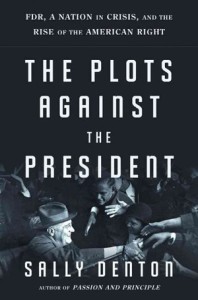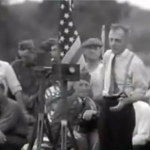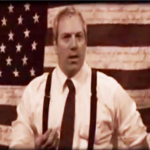The Coup You Never Knew
Most of us weren’t taught about “The Business Plot” of 1933.

When The Bankers Plotted To Overthrow FDR– Interview with Sally Denton, author of “The Plots Against The President”, NPR Books, Feb 2012
Remember learning about the “Wall Street Putsch” in high school? C’mon, you remember… that time when 1930’s industrialists tried to create a 500,000-member army of WWI vets to overthrow FDR, but then were outed by their hand-picked general before the coup went through, and then the House Un-American Activities Committee held hearings that found no one was responsible? Still don’t remember? Well, you weren’t just asleep in history class. “The Business Plot” is one of the most direct threats our democracy ever faced, but it’s also one of the least-known events in our history. Settle back, get comfortable, and let us tell you how a man was once offered dictatorship of the United States but turned it down because of his ideals: General Smedley Butler and the Wall Street Putsch…
Depression-era America was very different from today’s America, but they too faced a choice between authoritarian fascism and socialized democracy. No one yet understood the evil of Hitler, so people around the world looked to Fascists like he, Mussolini, and Stalin for strong, simple solutions to deep-rooted and complex problems. Business leaders here at home were furious about the “traitor to his class” Franklin Roosevelt and his notion of a social safety net to protect all Americans, an idea diametrically opposed to fascism. These 1-percenters-of-their-day weren’t content to let politics play out at the next election or even to simply obstruct the administration. According to General Smedley Darlington Butler, they planned a coup.

Vintage video of the real General Butler addressing the marchers of the Bonus Army
Here’s one of the better condensed accounts of the coup plot itself, along with links to General Butler’s testimony to the HUAC (the official AND actual versions!), General Butler’s other works calling out the military-industrial complex of his time, and several other avenues to explore if you want to dig deeper. It’s an insight into one of the most perilous and under-reported episodes in our nation’s history and a glimpse into the thoughts and writings of the singular man whose integrity preserved our democracy… at least until today. It’s our job from here on out.
The Business Plot To Overthrow Roosevelt

”War Is A Racket”- This short work by General Butler has become an anti-war classic. Email Charles@TomDwyer.com and we’ll send you a FREE copy!
Reposted from original article at Huppi.com
In the summer of 1933, shortly after Roosevelt’s “First 100 Days,” America’s richest businessmen were in a panic. It was clear that Roosevelt intended to conduct a massive redistribution of wealth from the rich to the poor. Roosevelt had to be stopped at all costs.
The answer was a military coup. It was to be secretly financed and organized by leading officers of the Morgan and Du Pont empires. This included some of America’s richest and most famous names of the time:
Irenee Du Pont – Right-wing chemical industrialist and founder of the American Liberty League, the organization assigned to execute the plot.
Grayson Murphy – Director of Goodyear, Bethlehem Steel and a group of J.P. Morgan banks.
William Doyle – Former state commander of the American Legion and a central plotter of the coup.

The Plot to Seize the White House: The Shocking True Story of the Conspiracy to Overthrow FDR by Jules Archer, 2007
John Davis – Former Democratic presidential candidate and a senior attorney for J.P. Morgan.
Al Smith – Roosevelt’s bitter political foe from New York. Smith was a former governor of New York and a codirector of the American Liberty League.
John J. Raskob – A high-ranking Du Pont officer and a former chairman of the Democratic Party. In later decades, Raskob would become a “Knight of Malta,” a Roman Catholic Religious Order with a high percentage of CIA spies, including CIA Directors William Casey, William Colby and John McCone.
Robert Clark – One of Wall Street’s richest bankers and stockbrokers.
Gerald MacGuire – Bond salesman for Clark, and a former commander of the Connecticut American Legion. MacGuire was the key recruiter to General Butler.

General Butler’s full “War Is A Racket” speech delivered by a re-enactor
The plotters attempted to recruit General Smedley Butler to lead the coup. They selected him because he was a war hero who was popular with the troops. The plotters felt his good reputation was important to make the troops feel confident that they were doing the right thing by overthrowing a democratically elected president. However, this was a mistake: Butler was popular with the troops because he identified with them. That is, he was a man of the people, not the elite. When the plotters approached General Butler with their proposal to lead the coup, he pretended to go along with the plan at first, secretly deciding to betray it to Congress at the right moment.
What the businessmen proposed was dramatic: they wanted General Butler to deliver an ultimatum to Roosevelt. Roosevelt would pretend to become sick and incapacitated from his polio, and allow a newly created cabinet officer, a “Secretary of General Affairs,” to run things in his stead. The secretary, of course, would be carrying out the orders of Wall Street. If Roosevelt refused, then General Butler would force him out with an army of 500,000 war veterans from the American Legion. But MacGuire assured Butler the cover story would work:
“You know the American people will swallow that. We have got the newspapers. We will start a campaign that the President’s health is failing. Everyone can tell that by looking at him, and the dumb American people will fall for it in a second…”
The businessmen also promised that money was no object: Clark told Butler that he would spend half his $60 million fortune to save the other half.
And what type of government would replace Roosevelt’s New Deal? MacGuire was perfectly candid to Paul French, a reporter friend of General Butler’s:
“We need a fascist government in this country… to save the nation from the communists who want to tear it down and wreck all that we have built in America. The only men who have the patriotism to do it are the soldiers, and Smedley Butler is the ideal leader. He could organize a million men overnight.”
Indeed, it turns out that MacGuire travelled to Italy to study Mussolini’s fascist state, and came away mightily impressed. He wrote glowing reports back to his boss, Robert Clark, suggesting that they implement the same thing.
If this sounds too fantastic to believe, we should remember that by 1933, the crimes of fascism were still mostly in the future, and its dangers were largely unknown, even to its supporters. But in the early days, many businessmen openly admired Mussolini because he had used a strong hand to deal with labor unions, put out social unrest, and get the economy working again, if only at the point of a gun. Americans today would be appalled to learn of the many famous millionaires back then who initially admired Hitler and Mussolini: Henry Ford, John D. Rockefeller, John and Allen Dulles (who, besides being millionaires, would later become Eisenhower’s Secretary of State and CIA Director, respectively), and, of course, everyone on the above list. They disavowed Hitler and Mussolini only after their atrocities grew to indefensible levels.
The plot fell apart when Butler went public. The general revealed the details of the coup before the McCormack-Dickstein Committee, which would later become the notorious House Un-American Activities Committee. (In the 50s, this committee would destroy the lives of hundreds of innocent Americans with its communist witch hunts.) The Committee heard the testimony of Butler and French, but failed to call in any of the coup plotters for questioning, other than MacGuire. In fact, the Committee whitewashed the public version of its final report, deleting the names of powerful businessmen whose reputations they sought to protect. The most likely reason for this response is that Wall Street had undue influence in Congress also. Even more alarming, the elite-controlled media failed to pick up on the story, and even today the incident remains little known. The elite managed to spin the story as nothing more than the rumors and hearsay of Butler and French, even though Butler was a Quaker of unimpeachable honesty and integrity. Butler, appalled by the cover-up, went on national radio to denounce it, but with little success.
Butler was not vindicated until 1967, when journalist John Spivak uncovered the Committee’s internal, secret report. It clearly confirmed Butler’s story.
“In the last few weeks of the committee’s life it received evidence showing that certain persons had attempted to establish a fascist organization in this country…
There is no question that these attempts were discussed, were planned, and might have been placed in execution if the financial backers deemed it expedient…
MacGuire denied [Butler’s] allegations under oath, but your committee was able to verify all the pertinent statements made to General Butler, with the exception of the direct statement suggesting the creation of the organization. This, however, was corroborated in the correspondence of MacGuire with his principle, Robert Sterling Clark, of New York City, while MacGuire was abroad studying the various form of veterans’ organizations of Fascist character.”
Needless to say, the survival of America’s democracy is not an automatic or sure thing. Americans need to remain vigilant against all enemies… both foreign and domestic.
Digging Deeper…
Transcript of Testimony of General Butler, Gerald MacGuire, and others to the HUAC, Dec 29, 1934 (with restored omissions)
Major General Smedley D. Butler Expose Fascist Coup in US Video by Occult Agenda, Apr 2012
1934: The Plot Against America by Scott Horton in Harpers Magazine, Jul 2007
Smedley Butler And The Business Plot, by Melissa Blevins on Today I Found Out, Jan 2014
Wall Street’s Failed 1934 Coup by Michael Donnelly on CounterPunch, Dec 2011
FDR- Man on the White Horse from Reformation.org
The Whitehouse Coup; BBC Radio 4 documentary, Jul 2007. 3-part video version on YouTube begins here.
Oh, Smedley: Was there really a fascist plot to overthrow the United States government? By Cecil Adams in The Straight Dope, Nov 2005
Outrage Over Obamacare Is Nothing Compared With FDR’s New Deal by Joshua Holland on Moyers & Company, Apr 2014












